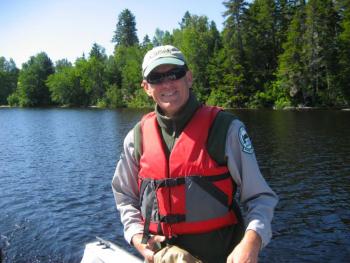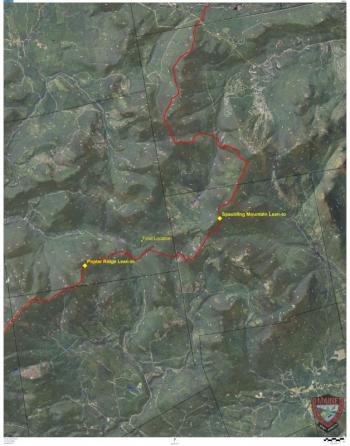TENANTS HARBOR — Think all you need is a pair of good boots to get in a quick hike after work this summer? Think again.
Author Peter Kick has some advice and it’s going to sound a lot like the Boy Scout motto, “Be prepared.”
“The one deceptive thing about hiking is that you don’t need any equipment and that is what always makes people the most susceptible to the elements,” Kick said. “So often people think they’ll just hike up in a T-shirt and shorts, and right back down from a 2,000 foot climb to my campsite or car in no time.”
But when something goes wrong, it goes very wrong when nightfall hits.
For Kick’s latest book, Desperate Steps: Life, Death, and Choices Made in the Mountains of the Northeast, he combed through the accident reports of 20 back country misadventures and misfortunes of New England’s biggest mountains to find the common thread of what went wrong and how those disasters might be averted in the future.
Kick, who lives part of the year in Maine, is a New York State licensed guide, and author of several hiking and cycling guides. His previous books include AMC Catskill Mountain Guide, AMC's Best Day Hikes in the Catskills & Hudson Valley, and Discover the Adirondacks.
Six of the stories in his latest book focus on Baxter State Park and the Appalachian Trail, including the most recent tragic case of thru-hiker Geraldine Largay, whose remains were found Oct.1 4, 2015, after a two-year search. According to a journal she kept while hiking and then while lost off the trail, she survived for nearly four weeks after she was reported missing. According to officials who investigated her disappearance and the subsequent location of her body, the campsite she set up after losing her way in the densely wooded remote area was just a 10-minute walk to a dirt trail that turns into a road. Searchers with K9s also came to within 100 yards of her at one during their effort to find and rescue her in the days after her husband reported her missing on the AT. She died from a lack of food and environmental exposure, according to published reports.
Like so many who have analyzed Largay’s case, Kick said he is still baffled about her inability to find her way out of the woods.
“I’ve spoken to the private search groups, the volunteers, the mercenary searchers and the Maine Warden Service, and they all had different ideas as to what happened,” he said. “This was a 66-year-old woman, who lost her hiking partner in the middle of the journey. Early on in her disappearance, Todd Remaley, chief ranger of the Appalachian National Scenic Trail, said the most likely thing that happened was the simplest explanation, that she wandered off the trail and got so lost she couldn’t find her way back. And to me that’s the part I can’t figure out. But not everybody has a good sense of direction and she was probably too frightened to try and find the trail again.”
He cited the Appalachian Mountain Club “Ten Essentials” list for the items that every outdoor enthusiast should bring on a backcountry excursion.
“What it really boils down to is, ask yourself any time you go out into the wilderness, if something happened, could you respond effectively to an emergency and spend a night in the field safely?" he said.
A map and compass tops this list. In Largay’s case, several media outlets reported that she had left behind a GPS device at a hotel, a piece of equipment that many people surmised would have ensured her survival if she’d had it with her.
“I don’t think she knew how to use it,” he said. “And, it’s not one of those necessary ‘Ten Essentials.’ I think a compass is more reliable because you don’t have to rely on batteries. You don’t need to know how to take a bearing or to triangulate; all you have to know is the four cardinal directions and to know where the trail is. But, you can’t walk endlessly on a compass bearing and come out alive. You have to know where the nearest waypoint is.”
He cited another case in Maine where the person might have benefited from knowing and using the 10 Essentials. That’s the story of Mike Hayes, an ultralight hiker, who got caught out for three days and nights on Mt. Katahdin and had to be rescued by helicopter. He didn’t have enough food, clothing or even an adequate topographical map. But, he was lucky, despite the odds and lack of preparation, because he was one of the few to make it out alive. And he was very contrite and said, “I really blew it,” said Kick.
After studying dozens of accident reports from all over New England, Kick said he concluded, “Very few people go into the wilderness prepared to spend the night. Having enough outerwear, enough water and food and a fire starter is the difference between hypothermia and possibly dying and just enduring an uncomfortable night. But, the one thing that gets people into the most trouble is the lack of light, like a headlamp.”
Kick knows this firsthand. “One time, I came down the Hunt Trail on Katahdin with three headlamps and I actually ran out of light by the time I got back my campsite about 11 p.m. I hadn’t changed the batteries and I thought, ‘Oh well, I’ll just be back down in no time. so that just goes to show that it’s easy to be complacent.”
To learn more about Kick’s book visit: Desperate Steps
Kay Stephens can be reached at news@penbaypilot.com





























